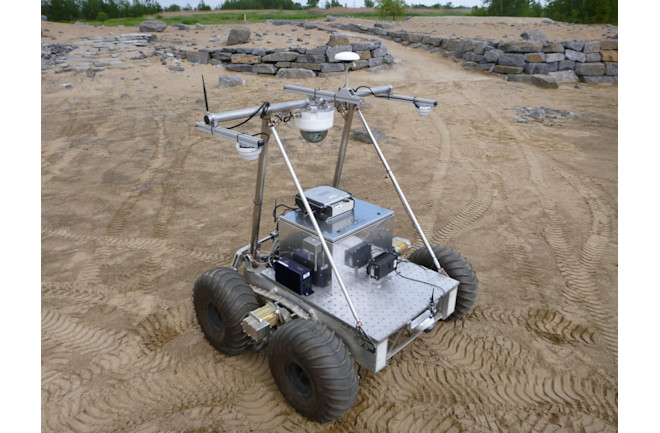This is the thirteenth in a series of reports from the HI-SEAS simulated Mars mission. Read others in the series here.

The HI-SEAS crew remotely drove this rover, called the Teleoperation Robotic Testbed (TRT). Credit: Canadian Space Agency Last week, from the comfort of our isolated habitat on Mauna Loa, I remotely controlled a lunar rover onto a rock where it got stuck. Luckily the rover wasn’t actually 250,000 miles away. It was on a simulated moonscape outside Montreal where an engineer was able to dislodge it. I’m not proud. But I can explain. As a simulated Mars mission, HI-SEAS is a testbed for all sorts of space-related projects. The idea is that, as a crew on a mock Mars mission, we can try out systems and offer helpful feedback on prototypes. Testing spacesuit simulators and antimicrobial workout shirts, socks and pajamas are just a few of the projects underway. And over a couple days last week, we got to have the experience that future Mars colonists might have---using a remote-controlled rover to explore our planetary surroundings.
Rover basics
Our rover experience was provided by the Canadian Space Agency, which owns five heavy-duty rovers, known as Junos. These machines can haul more than 600 pounds and come equipped with a collection of cameras, various types of wheels, and communication equipment. As a way to refine rover design and driver interfaces, the CSA offers researchers and astronauts the chance to remotely field test their machines. Driving a rover from afar can be tricky, though, especially with delayed communication and low bandwidth, also known as lunar communication conditions. Our rover’s onboard video cameras only refresh every second. The network connection speed is a sluggish 100 kilobytes per second. And a three-second communication delay can be added for further challenge. This all sounded like fun to our Canadian crew engineer and resident roboticist, Simon Engler. As a solider in Afghanistan, Simon developed bomb-sniffing robots. As a HI-SEAS crew member, he’s been working on a robotic arm for a remote farming project and on programming robotic pets to test their suitability for companionship on long missions. Simon’s also a big fan of Curiosity and other machines that roam the solar system, so he was happy to lead the crew for a rover test drive.
Test drive
Slope map for the rover's test terrain. Photo by Kate Greene, map provided by the CSA The CSA provided maps, basic operational instructions, and equipment---a video game controller, two field laptops, and a large-screen monitor---and asked us to complete six rover missions inside a souped-up sandpit near Montreal. This CSA Analogue Terrain is roughly the area of a soccer field and designed to mimic the challenging topography of lunar and Martian soil with hills, rocks, sand, craters and gullies. With only the information from the maps and the rover’s onboard cameras, we were to determine our “landing” location and steer around, over and through various obstacles on the course. When it came my turn to drive, I grabbed the controller and took a deep breath. My task was to get the rover out of a crater. The slope was about 20 degrees, so once I started, I would need to keep my speed or risk sliding back or taking a tumble. So I gunned it. But just as I crested the rim, I could see my trajectory was off. I should have aimed more to the left in order to make the gap between two rocks, just slightly wider than the rover itself. I tried to veer, but it was too late. The video feed refreshed, my thumb kept pressing the joystick, but the rover didn’t move. Since it wasn’t really on the moon, a friendly attendant was able to pick up the rover and reposition it at the starting point of the next mission. From there, using the heads-up display that gave me an idea of clearance on either side of the wheels, I successfully drove it through a narrow gully to complete the mission. But the going was slow. I was a little rock shy.
Watched from afar
Over the two days of the HI-SEAS rover experience, researchers at the CSA were logging the time it took us to drive various distances. David Gingras, robotics engineer at the agency, said that on average we covered a few meters per minute. He suggested that a real rover mission might require more speed. Toward that end, Gingras says, forthcoming versions of the rover could contain software that allow it do some of the driving itself. This might help complete missions faster. In fact, Gingras says, the CSA would like to try out various levels of on-board autonomy combined with delayed communications---a true test of rover-driver cooperation. http://youtu.be/ehFo05PMkDo Video by Sian Proctor



